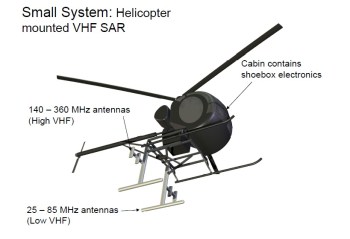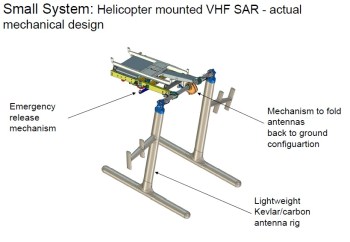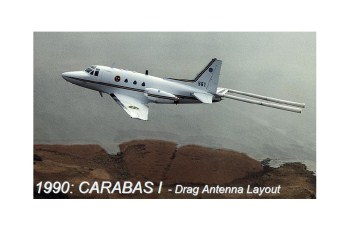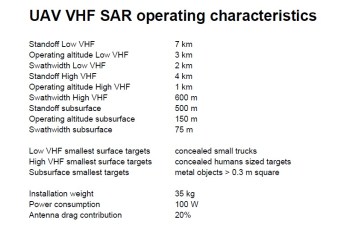CONNAN
SENIOR MEMBER

- Joined
- Feb 23, 2009
- Messages
- 3,381
- Reaction score
- 0
- Country
- Location
http://www.stratpost.com/saab-offers-drdo-underground-radar
Saab has offered its radar, CARABAS, to the Defense Research and Development Organization’s (DRDO) Electronics and Radar Development Establishment (LRDE) for evaluation. The radar can penetrate densely-forested areas and detect mines and Improvised Explosive Devices (IEDs) buried underground.
The DRDO had been shopping around for a radar that could provide the capability for the detection of threats in heavily-forested and remote areas affected by insurgencies and has selected the CARABAS to explore further possibilities. A radar with such capabilities would be useful in detecting threats in areas where security forces have to operate, patrolling roads and tracks under the canopy of dense foliage and surrounding forests, in difficult terrain.

CARABAS is a Very High Frequency (VHF) Synthetic Aperture Radar (SAR) that is mounted on aircraft to scan a target area for threats. The radar, which weighs 35 kilograms, can be fitted on rotary wing as well as tactical Unmanned Aerial Vehicles (UAVs)


On helicopters and UAVs, the antennas, which are made of Kevlar/carbon, retract when on the ground and unfold in the air. The antenna consists of two High Band dipoles, emitting waves of 140 to 360 MegaHertz (MHz) attached to two Low Band dipoles, with emissions between 25 to 85 Mega Hertz.

The system, when attached to an aircraft, manned or unmanned, scans the area for anomalies. Operational areas have to be regularly scanned for this radar to be most effective, as it detects these anomalies in terms of changes in the area being scanned. Such changes could include the presence of humans, vehicles and even metallic objects like mines and IEDs buried underground.

It’s VHF radar is able to penetrate foliage as well as ground surface because of its low wavelength and can detect ‘humans, mines and IEDs’. Saab says the radar can detect underground objects down to a depth of 3.4 meters (more than 11 feet) in wet soil, 6 meters (almost 20 feet) in dry soil and 26 meters (around 85 feet) in sand. This is when the radar waves hit the ground at the Brewster Angle, which optimizes their transmission by enabling them to penetrate the ground with no reflection.
With a power consumption of 100 Watts, the radar in foliage mode is capable of surveying 270 square kilometers from a standoff distance of 6 kilometers and an altitude of 2000 meters, enabling it to detect vehicles while emitting Low Band VHF waves. In the same mode, it can also detect human presence, emitting High Band VHF radiation, standing off from a distance of 3 kilometers and is able to survey an area of 45 square kilometers.

In subsurface mode, standing off from a distance of between 150 meters to 3 kilometers, the radar can survey an area of between 2.7 square kilometers to 45 square kilometers from an altitude of 30 meters to 700 meters and can detect buried mines and IEDs.
While the helicopter-mounted radar can detect to an accuracy of between half a meter to 2 meters, depending on the frequency, the UAV-mounted radar can detect concealed human and vehicular presence as well as subsurface metallic objects that have dimensions of less than 3000 square centimeters.
Versions of this airborne radar, already in operation in the Swedish Air Force, where it is configured for deployment on fixed wing aircraft, were first devised in 1990, with a Drag Antenna layout and then upgraded in 1997, to enable a Pushboom Antenna configuration.
Inderjit Sial, Saab’s Director – Industrial Cooperation, says the radar is currently undergoing tests on rotary wing aircraft in Sweden. DRDO officials are also expected to visit the country in August to witness the system in operation at a test range, as well as examine the source code of the system, to look for ways to configure it to Indian requirements. Towards the end of this year, the CARABAS will be available for configuration onto a Dhruv Advanced Light Helicopter (ALH) in India and be tested in a forested, remote area.
Sial also says the company is willing to manufacture the radar in India, if it is ultimately selected by the DRDO.
Saab has offered its radar, CARABAS, to the Defense Research and Development Organization’s (DRDO) Electronics and Radar Development Establishment (LRDE) for evaluation. The radar can penetrate densely-forested areas and detect mines and Improvised Explosive Devices (IEDs) buried underground.
The DRDO had been shopping around for a radar that could provide the capability for the detection of threats in heavily-forested and remote areas affected by insurgencies and has selected the CARABAS to explore further possibilities. A radar with such capabilities would be useful in detecting threats in areas where security forces have to operate, patrolling roads and tracks under the canopy of dense foliage and surrounding forests, in difficult terrain.

CARABAS is a Very High Frequency (VHF) Synthetic Aperture Radar (SAR) that is mounted on aircraft to scan a target area for threats. The radar, which weighs 35 kilograms, can be fitted on rotary wing as well as tactical Unmanned Aerial Vehicles (UAVs)


On helicopters and UAVs, the antennas, which are made of Kevlar/carbon, retract when on the ground and unfold in the air. The antenna consists of two High Band dipoles, emitting waves of 140 to 360 MegaHertz (MHz) attached to two Low Band dipoles, with emissions between 25 to 85 Mega Hertz.

The system, when attached to an aircraft, manned or unmanned, scans the area for anomalies. Operational areas have to be regularly scanned for this radar to be most effective, as it detects these anomalies in terms of changes in the area being scanned. Such changes could include the presence of humans, vehicles and even metallic objects like mines and IEDs buried underground.

It’s VHF radar is able to penetrate foliage as well as ground surface because of its low wavelength and can detect ‘humans, mines and IEDs’. Saab says the radar can detect underground objects down to a depth of 3.4 meters (more than 11 feet) in wet soil, 6 meters (almost 20 feet) in dry soil and 26 meters (around 85 feet) in sand. This is when the radar waves hit the ground at the Brewster Angle, which optimizes their transmission by enabling them to penetrate the ground with no reflection.
With a power consumption of 100 Watts, the radar in foliage mode is capable of surveying 270 square kilometers from a standoff distance of 6 kilometers and an altitude of 2000 meters, enabling it to detect vehicles while emitting Low Band VHF waves. In the same mode, it can also detect human presence, emitting High Band VHF radiation, standing off from a distance of 3 kilometers and is able to survey an area of 45 square kilometers.

In subsurface mode, standing off from a distance of between 150 meters to 3 kilometers, the radar can survey an area of between 2.7 square kilometers to 45 square kilometers from an altitude of 30 meters to 700 meters and can detect buried mines and IEDs.
While the helicopter-mounted radar can detect to an accuracy of between half a meter to 2 meters, depending on the frequency, the UAV-mounted radar can detect concealed human and vehicular presence as well as subsurface metallic objects that have dimensions of less than 3000 square centimeters.
Versions of this airborne radar, already in operation in the Swedish Air Force, where it is configured for deployment on fixed wing aircraft, were first devised in 1990, with a Drag Antenna layout and then upgraded in 1997, to enable a Pushboom Antenna configuration.
Inderjit Sial, Saab’s Director – Industrial Cooperation, says the radar is currently undergoing tests on rotary wing aircraft in Sweden. DRDO officials are also expected to visit the country in August to witness the system in operation at a test range, as well as examine the source code of the system, to look for ways to configure it to Indian requirements. Towards the end of this year, the CARABAS will be available for configuration onto a Dhruv Advanced Light Helicopter (ALH) in India and be tested in a forested, remote area.
Sial also says the company is willing to manufacture the radar in India, if it is ultimately selected by the DRDO.







